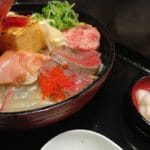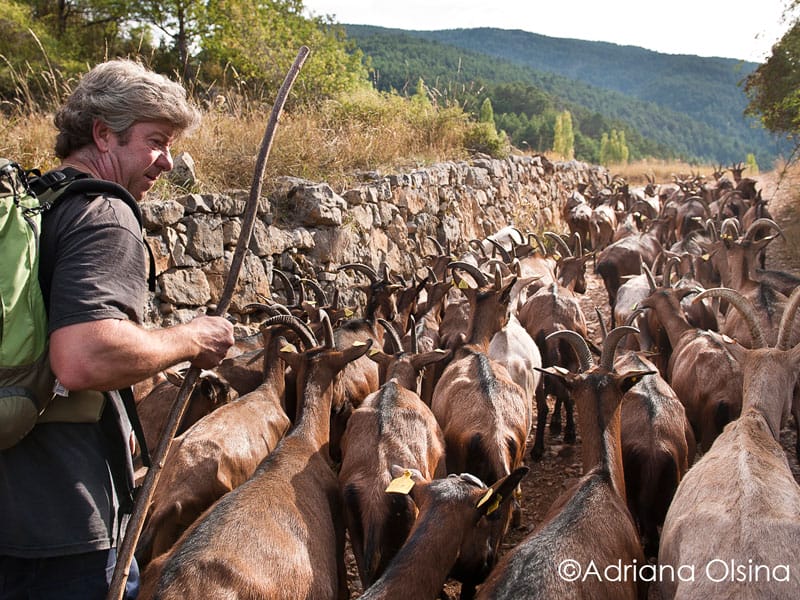Update: Poncelet Cheese Bar is sadly no longer open.
In the first part of our series on Catalan cheeses, we wrote about very old traditions – going as far back as the Middle Ages and perhaps even further – including the practice of transhumance by shepherds in the Pyrenees. As cheese expert Eva Vila explained to us, up until the 1980s, many artisanal cheeses were hard to come by; they could only be found in the small, often remote villages or farms where they were made.
The 1950s to 1970s saw a great quantity of people moving from the country to the city to find work, Vila told us. After 1975 – that is, post-Franco – Spanish hippies created communes on those abandoned farms and small villages out of the desire to reconnect with nature, cultivate gardens and raise animals with what little knowledge they had (and with mixed results).
Cheesemaking was one of the easiest activities these inexperienced back-to-the-land types could undertake. They used milk from their own animals or from those of other cows and flocks in the area. Some lacked electricity or running water or the proper equipment but were still able to make simple and quick mató, a light, fresh cheese with ancient origins. They could make and sell mató in the same day without any need for refrigeration. With their earnings, they improved infrastructure and production, learned more and made new cheeses.
That’s essentially the story behind Clúa, a small, abandoned village in the rocky Montsec mountains, which was reborn in 1979 thanks to a few urban families who started a commune there. It was tough going, especially for these families without resources or experience. The only animals that seemed to survive were the goats, and these would-be farmers realized that their predecessors had, in fact, raised goats and made cheese from their milk. Today, Formatgeria de Clúa is a dairy cooperative that produces on a small scale many different varieties of Montsec cheese, which are sold all over Catalonia and are easy to find in specialized shops in Barcelona. Most famous among them is the Cendrat del Montsec, a soft, white cheese made from raw, whole goat’s milk, which is aged 60 to 90 days. It has an elastic, creamy texture that melts easily, as well as a soft acidity, and is ripened with ash to produce a bloomy rind. The cooperative also makes the excellent Suau de Clúa, aged for the same amount of time but with an uncoated, clean rind.

In the 1980s, there was another group of young city transplants who started a new life in the countryside and also researched old cheesemaking traditions, with the support of the Catalan government. They wanted to find a use for the surplus goat’s milk in the area. Two of those pioneers, Enric Canut and Ramón Badía, discovered an amazing old cheese that was made in the volcanic area of La Garrotxa by a few farmers using simple methods: They squeezed the curds with their hands in a clay pot. Canut and Badía were captivated by this cheese and set out to make it using modern techniques. The result is a semi-firm goat’s milk cheese that has a soft, lightly acidic flavor and a gray mold (Penicillium glaucum) on its surface that grows naturally due to the humid conditions of that area. Known mainly as Garrotxa or also pell florida (“bloomy rind”), it has become its own style of cheese and has been shared by its creators in courses at their farm-school. It is now produced all over Catalonia in dozens of formatgeries and is exported internationally. There are many good craft versions of Garrotxa, not to mention more industrial kinds, but Ramón Ubach at Formatgeria Ubach in Vic makes a notable one called Garrotxa Primigenio, using the old recipe, and gives the cheese plenty of time to develop and grow its bloomy rind.
In Borredá, fellow 1980s pioneer Toni Chueca produces the wonderful cheese Bauma. Chueca and some friends started with a commune, which they turned into a business partnership. Most of their cheeses are made from goat’s milk, such as the much-awarded Bauma Madurat de Pell Florida. But recently, Chueca worked with affineur Eva Vila to create something unique for the Spanish market, and they came up with Bauma Pasta Láctica, which is made like a creamy goat’s milk cheese but with sheep’s milk – a highly unusual type of cheese that is hard to find not only in Spain but also in France. It has a compact paste and is softer and more delicate in flavor.
Eulàlia Torras is the Catalan neo-rural poster child. In 1976, she left the Gràcia neighborhood of Barcelona for the Pyrenees to start a herd of goats and to learn how to make cheese in particularly tough conditions. After much hard work and many changes – which also saw the complete transformation of the formerly abandoned village of Ossera – she began making in 1981 Serrat Gros, using raw goat’s milk from her farm, Cal Codina. Now one of Catalonia’s most highly prized cheeses, Serrat Gros (named for the goats’ favorite mountain for grazing) is delicate and delicious, with a soft paste. It’s pressed by hand and allowed to age for eight weeks. Torras retired in 2006 and sold the cheese farm to Raül Alcaraz and Merce Lagrava, a couple of professionals from Barcelona who had tired of the city and its hectic pace. They’re part of a new generation of cheesemakers from the city – well educated, with an innovative spirit, and also the perfect segue into the next chapter of our series on Catalan cheese: the 21st century!
(photos by Adriana Olsina / courtesy of Serrat Gros)
 June 17, 2016 Ichiba no Chubo
June 17, 2016 Ichiba no Chubo
The warren of streets surrounding Tsukiji – Tokyo’s main wholesale market – are filled […] Posted in Tokyo May 22, 2014 Los Limosneros
May 22, 2014 Los Limosneros
Juan Pablo Ballesteros comes from a family of entrepreneurs. In 1912, his […] Posted in Mexico City January 23, 2023 Formentor
January 23, 2023 Formentor
The Catalan ensaïmada is more than just a pastry – the sweet, spiral-shaped bread […] Posted in Barcelona
Published on April 30, 2015
Related stories
June 17, 2016
TokyoThe warren of streets surrounding Tsukiji – Tokyo’s main wholesale market – are filled with sushi joints, ramen stands, coffee shops and assorted other restaurants tucked between the stalls and knife makers.Walking around during morning hours, one might often wonder where the people who work inside the market have their meals. The gentrification of Tsukiji…
May 22, 2014
Mexico CityJuan Pablo Ballesteros comes from a family of entrepreneurs. In 1912, his great-grandfather, Rafael Ballesteros, opened Café Tacuba, which is today a food landmark in Mexico City’s Centro Histórico. Not far from this culinary treasure is Los Limosneros, which Juan Pablo opened more than a year ago, seeking to continue his family’s legacy while building…
January 23, 2023
BarcelonaThe Catalan ensaïmada is more than just a pastry – the sweet, spiral-shaped bread covered in powdered sugar serves as a direct link to the ancient Sephardic Jewish history of Spain and, more specifically, the Balearic Island of Mallorca (Majorca, in English). Despite the Jewish connection, the name of the pastry actually comes from the…

















































































